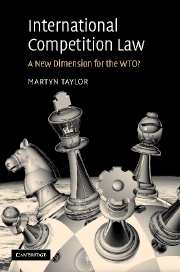Book contents
- Frontmatter
- Contents
- List of tables and figures
- List of abbreviations
- 1 Introduction
- PART I An International Competition Agreement is Desirable
- 2 Is competition law beneficial?
- 3 Is an international competition agreement desirable?
- 4 Is there a sufficient basis for an international competition agreement?
- 5 Have existing cross-border initiatives proved sufficient?
- PART II The WTO Would Provide a Suitable Institutional Vehicle
- PART III The Optimal Form for a WTO Competition Agreement
- APPENDIX: Draft negotiating text for a plurilateral WTO competition agreement
- Index
5 - Have existing cross-border initiatives proved sufficient?
Published online by Cambridge University Press: 17 July 2009
- Frontmatter
- Contents
- List of tables and figures
- List of abbreviations
- 1 Introduction
- PART I An International Competition Agreement is Desirable
- 2 Is competition law beneficial?
- 3 Is an international competition agreement desirable?
- 4 Is there a sufficient basis for an international competition agreement?
- 5 Have existing cross-border initiatives proved sufficient?
- PART II The WTO Would Provide a Suitable Institutional Vehicle
- PART III The Optimal Form for a WTO Competition Agreement
- APPENDIX: Draft negotiating text for a plurilateral WTO competition agreement
- Index
Summary
The derivation of a common antitrust standard among nations – a truly international antitrust law – does not arise simply through legislative act. It must be the logical culmination of the economic, political, and social development of a nation or groups of nations.
(Kintner, 1973)Chapter 5 of this book analyses existing initiatives at the bilateral, plurilateral and multilateral levels relating to the regulation of cross-border competition. Chapter 5 considers whether these initiatives alone may already be sufficient to address the externalities identified in Chapter 3 of this book. Chapter 5 has three principal sections:
Section 5.1 considers the nature of bilateral competition agreements and their limitations. Section 5.1 examines the evolution of such agreements from ‘first generation’ to ‘fourth generation’ agreements over the past three decades and identifies current initiatives towards increased bilateral co-operation. Section 5.1 also identifies positive comity and negative comity as important mechanisms to address the externalities identified in Chapter 3 of this book.
Section 5.2 identifies two important plurilateral competition initiatives, namely within the EU and APEC. Section 5.2 analyses the advantages and disadvantages of both of these initiatives and their current limitations. Section 5.2 identifies elements of plurilateral initiatives that could have multinational application and considers whether plurilateral initiatives alone would sufficiently regulate cross-border anti-competitive conduct.
Section 5.3 identifies existing multilateral competition initiatives, including initiatives within UNCTAD, the OECD and the WTO. Section 5.3 identifies the limitations of these initiatives and whether they could provide a vehicle for the development of a multilateral competition treaty.
- Type
- Chapter
- Information
- International Competition LawA New Dimension for the WTO?, pp. 106 - 144Publisher: Cambridge University PressPrint publication year: 2006



